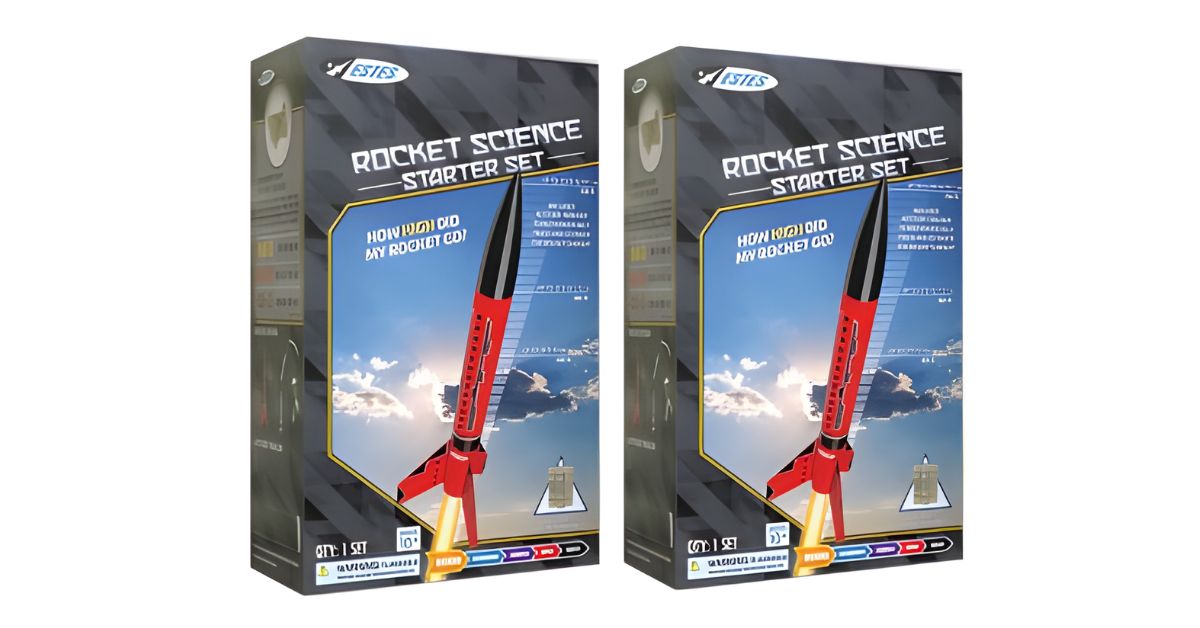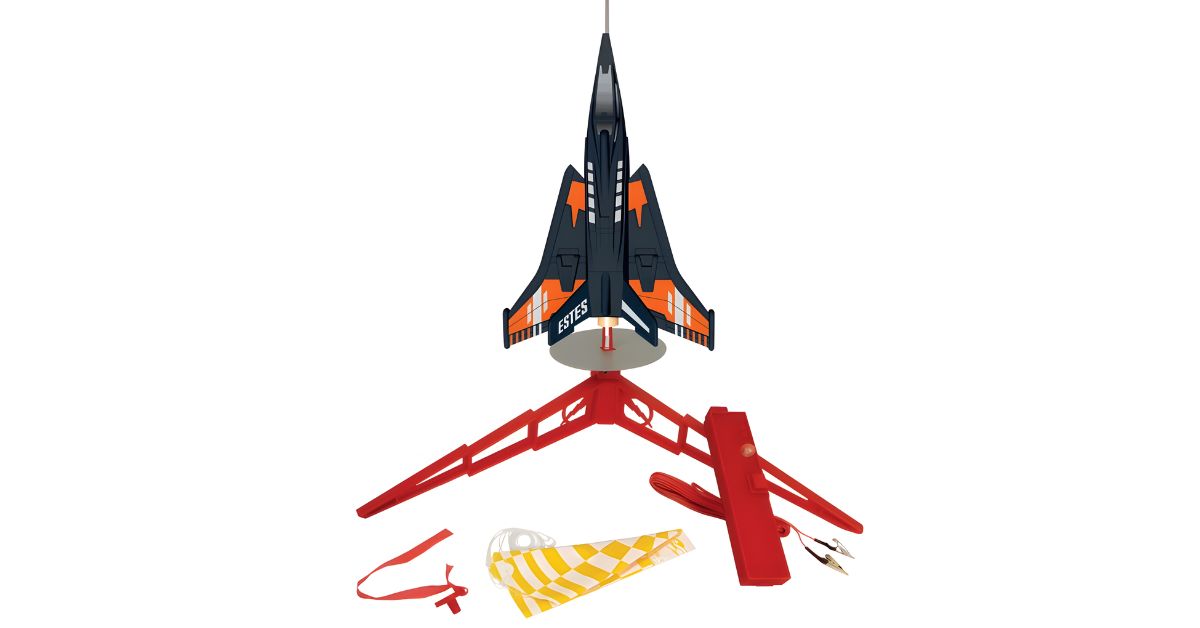Dual deployment might sound like a complicated concept meant for advanced rocketeers, but that’s far from the truth! While dual deployment does require some planning and setup, it’s an exciting, rewarding technique that opens up a world of possibilities for your rockets.
Regardless of your skill level, this introduction to dual deployment for model rockets will give you the opportunity to take your model rocketry to the next level. By the end, you’ll understand what it is, how it works, and how it can transform your model rocket adventures.
What Is Dual Deployment?
Dual deployment is a parachute recovery technique used to bring model rockets back to the ground safely. Unlike traditional single-parachute systems, a model rocket launch set with dual deployment uses two separate parachutes that deploy at different stages of the rocket’s descent. These are typically referred to as the drogue parachute and the main parachute.
Drogue Parachute Deployment
After the rocket reaches its apogee (the highest point of its flight), the drogue parachute deploys. By minimizing the drift caused by wind, this component slows the rocket down while allowing it to descend quickly and stably.
Main Parachute Deployment
At a pre-determined lower altitude, the main parachute inflates to slow down the descent for a soft and safe landing.
This method effectively reduces the walking distance to recover your rocket by preventing long, wind-driven drifts and guaranteeing a gentle touchdown that protects your rocket from damage.
Why Use Dual Deployment in Model Rocketry?
You might wonder why you should complicate things when a single parachute works just fine, but dual deployment offers several unique benefits. Follow along to discover how this method can improve your overall rocketry experience.
1. Minimize Recovery Drift
With single-parachute systems, one of the most common challenges is wind drift. A fully inflated parachute can carry your rocket far from the launch site, potentially into trees, water, or other hard-to-reach areas. Dual deployment reduces the time spent being carried by the wind by allowing the rocket to descend faster during the drogue stage.
2. Protect Your Rocket
Nobody wants to spend hours building and painting a rocket only to watch it slam into the ground or get tangled in its parachute lines. Thankfully, dual deployment provides a controlled descent to make sure your rocket lands softly and remains intact for future flights.
3. Fly Higher With Confidence
If you’re aiming to launch rockets to greater altitudes, dual deployment isn’t just helpful; it’s practically essential. Without it, higher altitude flights often result in rockets drifting out of range, especially in windy conditions. Even from impressive heights, dual deployment ensures you can confidently recover your rocket.
4. Learn Advanced Techniques
For educators, parents, and youth mentors, dual deployment is a fantastic way to teach STEM concepts such as physics, engineering, and problem-solving. It can deepen students’ understanding of aerodynamics and recovery systems while keeping the activity hands-on and enjoyable.

How Dual Deployment Works
While the concept might sound complex, the mechanics of dual deployment are relatively straightforward. It all comes down to equipping your rocket with the right components and understanding how they work together.
The Components
- Two Parachutes: The drogue parachute stabilizes the rocket after apogee, while the main parachute ensures a gentle landing.
- Ejection Charges: Small, controlled charges deploy both parachutes at different times.
- Altimeter: This measures the rocket’s altitude and triggers the ejection charges during the descent.
- Rocket Recovery Bay: A compartment within your rocket to store the parachutes and keep them properly packed until deployment.
- Shear Pins: These hold sections of the rocket together during flight but are designed to allow separation when the ejection charges fire.
- Shock Cords: By connecting components, these cords ensure everything remains intact during the descent.
The Process
- Launch and Ascend: Once the motor ignites, your rocket powers upward into the sky with adrenaline-pumping speed.
- Apogee and Drogue Deployment: After the motor runs out and the rocket reaches its apogee, the altimeter signals the drogue ejection charge to deploy the small parachute.
- Main Deployment at Lower Altitude: At a preset altitude (e.g., 500–800 feet), the altimeter activates the main parachute ejection charge, inflating the larger parachute for a slow, controlled landing.
- Safe Recovery: Your rocket lands softly in the recovery zone, ready for retrieval and reuse.
Tips for Success With Dual Deployment
Now that you know the basics, use these tips to achieve a seamless and successful dual-deployment setup.
Start Small
If you’re new to dual deployment, begin with a mid-power model rocket that supports dual-parachute systems. Before jumping into high-power rocketry, practice assembling and launching your rocket.
Pick the Right Altimeter
Your altimeter is the heart of your dual deployment system, so make sure to choose one that’s reliable, easy to use, and compatible with your rocket. Popular options include the PerfectFlite and Jolly Logic Altimeters. Whatever you choose, read the manufacturer’s instructions thoroughly.
Test Your Components
Ground testing is crucial! Test your ejection charges on the ground to double-check that they’re powerful enough to deploy your parachutes effectively. With careful testing, you can avoid surprises on launch day.
Pack Your Parachutes Properly
Improperly packed parachutes can fail to inflate or deploy, ruining an otherwise perfect flight. To protect them from ejection heat, fold your parachutes neatly and secure them with flame-resistant wadding or Nomex blankets.
Familiarize Yourself With the Launch Site
Check the layout of your launch site, wind conditions, and any potential obstacles like trees or bodies of water. Dual deployment minimizes drift, but you still need to choose a clear recovery area.
Why Dual Deployment Is Worth It
Imagine launching your rocket to 2,000 feet above the ground, watching it soar majestically into the sky. At apogee, the drogue parachute pops out, and your rocket begins a stable, controlled descent. The excitement builds as the main parachute deploys at 600 feet, floating your rocket gently back to you. This is the magic of dual deployment.
If you’re an educator or parent, picture the excitement on a child’s face as they use mathematics and engineering principles to achieve a perfect rocket launch and recovery. You can take these magical moments to the next level with dual deployment.

Are You Ready To Try Dual Deployment?
Dual deployment might seem a little daunting at first, but with the right preparation, it can quickly become one of the most enjoyable and rewarding aspects of model rocketry. Now that you’ve read this introduction to dual deployment in model rocketry, you’re ready to use this technique to maximize the fun and excitement of building model rockets.
Ready to get started? Head over to our website to stock up on all your model rocket essentials. Whatever you need to achieve a perfect flight, we’ve got you covered.


